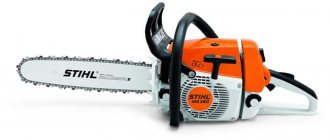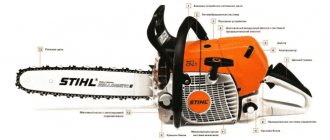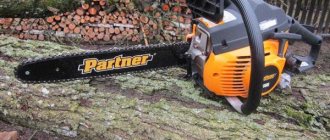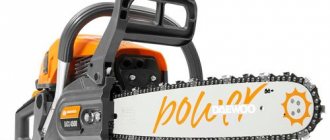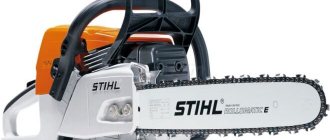How to Start a Makita Chainsaw
How to start a chainsaw
The question of how to start a chainsaw can be divided into two parts:
The information from the first part will be useful to those who have lost the annotation, or to those whose annotation is not very informative.
The 2nd part will tell you what needs to be done if you have done everything according to the instructions correctly, but the chainsaw still does not start. It will also be useful for those who have trouble starting their chainsaw.
1. Start the chainsaw according to the instructions
Different chainsaws may start differently. Let's look at two more popular mechanisms that are used to start a chainsaw, available today. For example, let's take the Stihl MS 180 and Echo CS-352ES chainsaws. If you have a chainsaw of a different brand, then just try to start it by analogy, because most likely you have the same or a similar mechanism.
Before starting the description of the starting process, I would like to see that some chainsaws have written in the annotation that before starting the chainsaw it is necessary to turn on the critical stop brake. It's safer this way. But with a fixed brake, it is more difficult to start the chainsaw, so it is better to unlock it. If you do everything wisely, then the chainsaw will not do anything for you during startup. If you are afraid that without locking the brake, the chainsaw, when you try to start , will be able to cause harm to you, then it is better not to take up this tool at all.
So, let's start with the Stihl MS 180.
Now we will analyze the 2nd 2nd mechanism that allows you to start the chainsaw .
Chainsaw Makita EA3202S40B
Launch of the Makita DCS 4610 chainsaw sawing pine wood
of Makita chainsaw this year
DCS 4610, dry pine firewood. The saw did not disappoint.
2.Why doesn’t the chainsaw start?
If you have done everything according to the instructions, but the chainsaw still does not start, then something is wrong with it. Several of the most common reasons may be to blame for this: no spark; fuel is not supplied; The air filter is clogged. So, below we propose a procedure that will help identify the reason why the chainsaw does not start.
Procedure if your chainsaw does not start
The first thing I would like to note is that if your chainsaw does not start, do not turn any screws on the carburetor. If you are not a specialist, you still won’t be able to set anything up on your own and you won’t be able to start the chainsaw.
Perform the following steps necessary to start the chainsaw in the order indicated, starting with the next action only if the previous one does not help.
Thus, in this article we discussed how to start a chainsaw “according to the instructions,” as well as what to do if the chainsaw does not start. We hope you found these tips helpful.
Source
Starting the saw with decompression valve
Users from time to time ask what, how to start, if the tool has a decompression valve. This is not available on the 250 model. As soon as the first flash occurs, the valve will be operating in normal operation mode. The motor control lever will be set to the position where the choke is open. The start-up will continue; here you need to apply additional pressure on the decompression valve. It does not make the start-up fast, but it simplifies the process and makes it comfortable, because at the time of start-up the operator will have to put in less effort.
If you are not convinced that you understand how to start the Shtil 180 chainsaw, then remember what it really is, that equipment with a valve, and it doesn’t matter whether it has a hot or cool engine, must be started using the valve. This will make it easier to turn the engine. This way it will not be difficult to extend the life of the starter and reduce the number of broken laces; such chainsaws have a larger cylinder volume and compression.
How to start a chainsaw: features of proper operation
Many people buy chainsaws for the first time, without any experience with this tool. Despite this, to learn how to use the tool, there is no need to take special courses. After the purchase, there is a great desire to quickly test the tool in use. To do this, be sure to first read the operating instructions for the tool, as well as safety precautions when working with a chainsaw. In this article we will look at how to start a chainsaw correctly and how to operate it.
Features of the first and subsequent launches
Learning how to start a chainsaw correctly is, in principle, not difficult. The necessary skills are acquired directly during operation.
The chainsaw is started by a cord starter, which in most modern models is combined with an inertial or spring easy start system. A correctly adjusted mechanism reduces the force required to start the engine by almost half.
Since it is impossible to start a chainsaw without a starter, to extend its life it is necessary to develop a smooth, slightly accelerated pull of the cord that does not create large loads on the design of the starting device.
- For the first start, the tool, filled with fuel and chain oil, should be placed on a level surface, the accidental start prevention system and the emergency stop brake of the saw set must be unlocked. If you have a primer, you should pump fuel into the carburetor.
- To start the engine, set the throttle to low speed and, holding the tool by the handle, pull the starter handle. Starting a chainsaw for the first time, as they say, with half a turn, most likely will not work. Even a fully serviceable and adjusted tool “gets it” in 3-4 attempts.
- In idle mode, the piston group and connecting rod-crank assembly operate under oil starvation conditions, so the idle time must be limited to a minimum.
How to start a chainsaw: preparation for launch
Every master who owns a chainsaw should know how to start it correctly. Initially, it should be noted that in order to start the tool, it must be filled with fuel. For this, not just gasoline is used, but a gasoline-oil mixture.
It is important to know! Pure gasoline cannot be used to operate chainsaws. It is necessary to refuel exclusively with a mixture of gasoline and the appropriate oil for two-stroke engines.
First you need to figure out how to properly prepare the gasoline-oil mixture. These proportions are naturally indicated in the instructions, but since few people read them, this issue should be considered in detail.
Gasoline grade AI92 and higher is used as fuel. You will also need to use the appropriate oil, which can be purchased at the same place where you bought the chainsaw. The proportion of gasoline and oil is 1 to 50, after mixing which must be thoroughly stirred. In this case, the mixture should be prepared in a separate container (plastic bottle), since it is not only convenient to store the prepared fuel mixture in it, but also convenient to fill it into the tool tank through the small diameter of the gas tank hatch.
The prepared mixture should be poured into the fuel tank, the lid of which is indicated by an image of a gas station. This is very important, since chainsaws have two similar tanks. The second tank is intended for filling oil, which is used to lubricate the bar and chain during the operation of the tool.
It is important to know! After refueling the gas tank, do not rush to start the tool. You should also be sure to fill the oil tank with oil to prevent the chain from overheating, which could result in damage to the chain.
As an oil for lubricating the chain, it is recommended to use a special branded or motor oil for the car, but under no circumstances should it be used. If you see your neighbor putting waste into a chainsaw, then you should not repeat his mistakes, as this significantly reduces the service life of not only the chain, but also the tool itself.
How to adjust the carburetor
To make adjustments, you must first turn the maximum and minimum speed screws until they reach their highest resistance. After that, turn them back, leaving them in this position after one and a half turns. Then, the engine warms up for ten minutes at medium speed. It is important to ensure that the chain does not move. If the engine stalls, you must immediately tighten the adjustment screw until it stops.
Carburetor Champion 237
Also, chain tension is important for proper operation of the Champion chainsaw. You can do it yourself. Poor tension can cause the chain to fly off the bar or damage it. With excessive tension, the load on the motor increases, which subsequently wears out the saw faster.
In order to adjust the chain, you need to: inspect the tensioning mechanism, which is located to the right of the side cover that secures the axle, unscrew the bolts that are responsible for fixing the tire. Adjust the tension level using the adjusting screw, move the axle forward, adjust the chain, and tighten the bolts.
How to properly break in a chainsaw - after purchase and overhaul
Running in a chainsaw is carried out immediately after purchasing the tool. You need to know that after purchasing a new tool, it needs a break-in procedure. This procedure is the grinding in of engine parts. The seller of the tool informs about the need for such a procedure, so the buyer or future owner can only figure out how to properly break in the chainsaw and what needs to be done.
Step by step instructions
When the brake is activated, the assembly process is much slower, so everything is still safe and convenient, you can turn on the mechanism without using the brake equipment.
1 diagram of the standard mechanism
Our other article will also help you make a choice in favor of a specific brand of chainsaw.
Chainsaws made in Russia. Low price with fairly high quality.
2 diagram of the standard mechanism. How to start the saw
Watch more in the video:
Running in a new chainsaw or the importance of this event
During the grinding of parts, working gaps are formed between the cylinder and the piston rings. Even at the break-in stage, compression in the cylinder increases, which has a positive effect on the operation of the internal combustion engine and the power of the tool. The procedure allows you to increase the service life of a two-stroke engine, and if you do not pay attention to this process, the engine may jam the first time you use the chainsaw.
In addition to reducing the service life of internal combustion engine parts in the absence of running-in, the engine will work significantly worse, and instead of the amount of horsepower declared by the manufacturer, the tool will produce 2 times less. Any new chainsaw needs running-in, regardless of who its manufacturer is. You also need to run in chainsaws that have undergone engine overhauls, but we’ll talk about that separately. Not only does the internal combustion engine of a new chainsaw need grinding in, but also the saw set - the chain and bar.
Many beginners wonder whether running in a chainsaw is necessary. And sometimes a simple answer is not enough for a person to understand how important it is to break in the tool. To understand the importance of break-in, you need to know what happens when you start the engine:
There are different opinions among tool owners about how to properly break in a chainsaw. Some masters recommend carrying out the procedure exclusively by running the engine at idle, while others, on the contrary, believe that the tool should be allowed to work not only at idle, but also under moderate load. Having figured out the question of whether running in a tool is necessary, let’s move on to clarifying the features of the correct execution of the procedure.
The answer to a popular question about starting a chainsaw
On the Internet, you can often find questions about how you can start a chainsaw without using a starter. The answer is simple - it is basically impossible to start a chainsaw without a starter. Manufacturers do not provide any alternative starting methods, because even if you remove it and somehow start the saw, it will be impossible for it to work due to problems in the cooling system. It contains a volute that transmits a flow of cold air from the flywheel impeller to the cylinder.
Is it necessary to load the chainsaw during break-in?
Some tool sellers recommend that after purchasing a chainsaw, buyers carry out the process of grinding in parts with complete elimination of the load. It even goes so far as to have owners remove the chain and bar and let the engine run at zero load. Is this approach to the procedure considered correct? This approach is not recommended for the following reasons:
That is why, before you start running in the chainsaw, you need to install the bar and chain on the tool and ensure the correct tension. Next, you will need to fulfill some more important conditions:
If you cannot turn on and start your chainsaw
When all actions are performed in the prescribed order and the chainsaw does not start working, its mechanism fails. This is usually caused by common and easily fixed problems such as lack of spark, clogged fuel supply or clogged air filter. To start a chainsaw, you need to find the cause and take the necessary measures to eliminate it.
Only the right actions must be taken. . If a person does not know what to do, there is no need to act rashly. Do not disassemble the device, especially handle the carburetor. It is impossible to unscrew any screws on it because if its device is broken, it is impossible to repair the chainsaw without professional equipment.
Lists the actions that must be performed in a strict order. Only by moving from one event to another will you be able to determine the exact cause of the problem and quickly fix it without damaging other parts. Algorithm of actions to be performed in case of failure of the chainsaw:
If a spark occurs and the device cannot be made to work, the following steps must be followed.
How to properly prepare a gasoline-oil mixture for a chainsaw during break-in
As has already been said, during the process of running in a chainsaw, grinding in of parts occurs. To increase the quality of grinding in parts, it is recommended to fill the tank with gasoline with an increased amount of oil than recommended by the manufacturer. Why is this necessary? During lapping, an increase in friction is observed, so the parts heat up more. To reduce the heating temperature, the friction coefficient should be reduced, which is possible by preparing gasoline with an increased amount of oil.
The gasoline used is AI-92, and you should not use fuel with a higher octane number, as this will only harm the instrument. The buyer must only be sure that the gasoline being poured is of really high quality and corresponds to the declared resistance to ignition under compression.
Oil for preparing the fuel mixture should be used only and exclusively two-stroke. How much oil should be added to 1 liter of gasoline during break-in? To do this, refer to the instructions supplied with the tool, where the manufacturer indicates the normalized value. As a rule, this indicator corresponds to a value of 1 in 50 or 1 in 40. Less common norms are 1 in 30 and 1 in 25, and often such values are presented for Chinese chainsaws. Now let's find out how to properly prepare the gasoline-oil mixture when running in a chainsaw? When grinding in instrument parts, you need to rely on the manufacturer’s recommended proportion value with an addition of 20% or 5-10 ml.
It is not recommended to store the finished mixture for more than 2 weeks if alcohol is present in the composition. If you are sure that gasoline is not diluted with alcohol, then the storage period increases to 2-3 months. Knowing how much oil needs to be added to gasoline when running in a chainsaw, you can safely prepare the mixture and begin the procedure.
Manufacturer and basic equipment
Champion is a Russian brand; the first mentions of it appeared in 2005. Today, the company's main production is concentrated in factories in China, but many components are purchased from Western Europe, Japan and the USA. In particular, the company has a close relationship with the American engine manufacturer Briggs & Stratton.
The design and ergonomics of the Champion 237-16 chainsaw were developed taking into account the requests of users from Ukraine and the CIS countries, in particular, the option of heating the carburetor is provided.
Basic equipment of the Champion 237 chainsaw:
- Cardboard packaging and sack bag.
- Russian-language instructions for maintenance and operation.
- Measuring tank for preparing the fuel mixture.
- Saw guide - 1 pc.
- Chain for saw – 1 pc.
- A file for sharpening a chain.
- Metal stop.
- Set of screwdrivers and keys.
- Warranty card.
Video review on unpacking the Champion 237 saw:
Fill the tank with chain oil and check the serviceability of the oil pump
The oil tank must only be filled with special chain lubricant. After filling the tool with oil, you can start the engine and make sure that the oil pump is working properly. This is quite simple to do, for which you need to place a blank sheet of paper on the end side of the tire. After starting the engine, and with increasing speed, the chain will rotate, and oily spots should appear on the paper, indicating a normal supply of chain oil to the tool tire.
Malfunctions and ways to eliminate them
| Malfunction | Cause of malfunction | Remedy |
| The saw won't start | No fuel. No spark | Fill in the fuel mixture. Dry and clean the spark plug and, if necessary, replace it with a new one. |
| When idling, the engine spontaneously gains speed. | Air supply is difficult or absent. | Clean the air filter and replace it if necessary. |
| When you press the accelerator, the engine does not gain speed. | Dirty carburetor. | Clean the carburetor. |
| The engine stalled while running. There is no spark. | Problems with the ignition unit. | Repair or replace the ignition unit. |
The procedure for breaking in a new chainsaw - setting up the tool and starting the engine
In order for the chainsaw break-in procedure to be as efficient as possible, you will need to purchase a tachometer. This device is needed to measure the number of crankshaft revolutions when the internal combustion engine is running. This device will be needed not only for adjusting the carburetor of the tool before running it in, but also during operation of the chainsaw. The principle of adjusting the carburetor before running in the tool is that it is necessary to reduce the number of maximum revolutions by 600-700 rpm. The maximum speed reaches 12.5 thousand rpm, but achieving them during break-in is extremely dangerous. In addition, a decrease in maximum speed helps to enrich the mixture with fuel, which has a positive effect on the grinding in of parts.
The tachometer is connected to the tool, and we proceed to adjust the carburetor, enriching the mixture. For this purpose there is a special screw on the carburetor H. It allows you to increase or decrease high speeds. By rotating screw H, it is necessary to achieve a tachometer reading 600-700 rpm lower than the maximum value, that is, reduce it to 11900-11800 rpm.
By reducing the maximum speed, it is possible to obtain a rich mixture, so more gasoline and oil are supplied to the combustion chamber. This eliminates overheating of the engine, and thereby wear of parts. After completing the break-in process, the chainsaw carburetor will need to be adjusted again to operating mode.
Carburetor adjustment can be performed on professional and semi-professional chainsaws, but the procedure is not mandatory if the manufacturer’s documentation does not say anything about this. The break-in will be successful if you do not adjust the carburetor, but at the same time eliminate the possibility of increasing the speed to the maximum value. Household tools do not need to perform such actions at all. After setting, the engine starts.
Chainsaw starting algorithm
In order to start a chainsaw, several processes must occur simultaneously. This is the supply of the fuel mixture under the engine piston, its maximum compression and the supply of a spark at this moment for ignition and starting.
All these processes occur at the moment when we pull the starter handle. If you have a new chainsaw, then do not forget that it must be run-in.
But not everything is as simple as it seems; the fuel for starting a cold and hot engine must differ in the quality of the air mixture. For example, a hot internal combustion engine can start with a normal air level, at which it operates stably and confidently maintains idle speed. The same amount of air will be too much to start a cold engine, and before starting the chainsaw you will have to pull the starter 10 times, or maybe more. How to solve this problem?
To reduce the amount of air and increase the fuel supply, chainsaw manufacturers installed a special damper in the carburetor, which is responsible specifically for the process of adjusting the amount of air at the time of starting the internal combustion engine.
Starting the saw engine with its help is several times faster, which increases the operating time of the starter and the entire saw as a whole.
Starting the saw in the same place where it was fueled is dangerous.
So how to start the saw correctly? The startup algorithm is as follows:
- Close the air damper completely. To do this, all chainsaws have a special lever, which, when pulled, closes.
- Using a primer, pump fuel into the carburetor. This is necessary so that the internal combustion engine does not require several power strokes to fill the carburetor.
- Make several movements with the starter until the first fire occurs in the cylinder. It is called the first outbreak. We will dwell on this point in more detail because of its extreme importance for proper starting. It is at the moment of the initial fire that optimal conditions are created for subsequent startup. Under the influence of the temperature from the first flash, the fuel in the cylinder evaporates, forming gas vapors, and as everyone knows, they are the ones that participate in the operation of the internal combustion engine. Therefore, the next stage is to complete the process and finally start the chainsaw engine.
- Open the choke valve halfway and operate the starter. After these steps, the chainsaw should start and start working at high speeds; to normalize them, you need to press the speed control lever to the maximum and immediately lower it. After these actions, a properly adjusted engine will go into idle mode and reduce speed.
How to properly break in a chainsaw
Today, chainsaws are produced by different manufacturers (well-known ones - Shtil, Husqvarna, Makita, Interskol and others, and little-known ones - Carver, Echo, etc.), but the running-in process will be the same for all devices. It involves performing the following actions:
With each subsequent tank, it is necessary to increase the operating time of the engine. However, this applies only to professional and semi-professional units. Domestic chainsaws must be run in with extreme caution and should not be allowed to overheat. It is better to start the engine more often, but at the same time let it run in short-term modes, than vice versa.
What to do if the chainsaw does not start?
There are many factors why a chainsaw will not start if the starting technology is followed. The most common causes and ways to eliminate them:
If these simple tips do not help, you need a full diagnosis of the problems. It is recommended to take the chainsaw to a service center, where they can check the compression of the cylinder and crankcase, as well as the operation of the carburetor.
Proper starting of the chainsaw ensures stable and reliable operation of this tool. When starting, before starting sawing, you should properly prepare and fill the fuel mixture and adjust the main structural elements. It is important to take into account weather conditions, as well as the features of a particular model.
Source
How to break in a saw set
Before starting the internal combustion engine of the unit, it is recommended to lubricate the chain with oil. To do this, apply specialized chain oil to the headset, but the best option is to put it in a container with oil for a couple of hours before installing the chain on the chainsaw. During this time, all chain links will be saturated with lubricant, which will reduce the coefficient of friction and increase service life.
Install the chain on the chainsaw and ensure its tension so that it rotates freely when applied by hand. The correct chain tension is checked by lifting it at the top of the bar. In this case, the shank of one link should be completely visible. When running in a chainsaw, you need to regularly check the chain tension and tighten it.
Features of proper running-in of the unit after major repairs
Not only new chainsaws need grinding in parts, but also units that have undergone a major overhaul of the internal combustion engine. The process of running in a chainsaw motor that has undergone a major overhaul (that is, after replacing the piston) is completely similar to the instructions described above. The only difference is that the grinding process will not last as long as for a new tool.
Typically, the running-in period of a chainsaw after a major overhaul lasts for the duration of burning 1-2 full tanks of fuel. Similarly, you need to set the carburetor to the minimum maximum speed values. After completing the process, you will need to adjust the carburetor again by turning screw H clockwise a quarter turn. However, it is worth understanding that in order to achieve the most effective carburetor setting, its adjustment must be carried out using a tachometer.
Among owners of new tools, the question often arises: how to break in a Chinese chainsaw? The process of running in Chinese, European and domestic units is identical, as described in the instructions above. The most important thing is to determine whether the tools are household or professional. The difference between these tools is significant, and the most important thing for a household chainsaw is to prevent it from overheating. Professional and semi-professional units are more reliable, but during break-in it is also necessary to adhere to the engine operating time interval.
To increase the service life of the tool, you need to provide proper care from the first day. And this care must begin even before starting the chainsaw engine and cutting firewood.
Source
Start the chainsaw according to the instructions
Different chainsaws can be started in different ways. We will analyze two of the most popular chainsaw starting mechanisms that exist today. For example, take the Stihl MS 180 and Echo CS-352ES chainsaws. If you have another brand of chainsaw, just try to start with an analogy, because most likely you have the same or similar mechanism.
Before we begin describing the startup process, I want to note that for some chainsaws the instructions say that before starting the chainsaw, you must turn on the emergency stop brake. They say it's safer. However, starting a chainsaw using a stationary brake is more difficult, so it is better to unlock it. If you do everything wisely, the chainsaw will not do anything when starting. If you are afraid that not trying to engage the chainsaw brake will cause you harm, then it is better not to use this tool at all.
So, let's start with the Stihl MS 180.
- The first thing to do before starting this chainsaw is to move the control lever to the down position (Fig. 1). Please note that this lever only moves to the bottom of the chainsaw when you press the gas button. Therefore, while holding the throttle button, push the lever down. Thus, we close the valve in the carburetor and fix the gas on the chainsaw in the pressed position.
Rice. 1 After this, to start the chainsaw, you begin to vigorously move the starter handle until you hear the chainsaw trying to start and then stop. After this, move the lever to adjust the position of the damper on the chainsaw one step up (Fig. 2).
Now we will analyze the second second mechanism that allows you to start the chainsaw.
Rice. 5 Then press the primer several times to replace (Fig. 6). Gasoline is pumped into it and then press another 3-5 times. If you have a chainsaw without primer, proceed to the next step.
Rice. 6 Now on the chainsaw, pull the lever completely out to adjust the position of the sash (Fig. 7). In some chainsaws, to start it, this lever can only be stretched when the gas button is pressed, and the gas button itself is locked in the pressed position. Others don't have to press the gas button. However, in this case, the gas on the chainsaw is fixed automatically or not fixed at all.
Chainsaw “Makita” DCS4610. Technical characteristics and rules of use
Content
The Makita DCS4610 chainsaw is produced by the famous Japanese manufacturer Makita, which began its activities back in 1915. The Makita company at that time was engaged in repairs of negators, electric motors and transformers, and also launched the production of its electrical equipment.
Over the entire period of its existence, more than 450 types of high-quality hand, gas and power tools, as well as more than 1,400 types of accessories for units, have been developed.
The popularity of the brand has increased so much. that more than 120 countries allowed Makita brand representatives to be located on their territory. As for the factories, they are located on the territory of the following states:
Fake and original
It turned out to be not so difficult to identify a Chinese counterfeit, for this you need:
The Makita DCS4610 chainsaw is a semi-professional tool designed for both home use and public utilities. The saw will cope with sawing boards and logs, and with felling trees, carefully and quickly cutting branches, etc. The weight of the chainsaw is 4.75 kg. The robust housing houses a two-stroke carburetor engine with a capacity of 2.31 liters. With.
Electronic non-contact ignition system. A manual inertia starter starts the engine, an engine brake is provided, there is protection for the operator’s hands and a chain catcher. The primer ensures easy starting of the tool - it pumps the fuel mixture into the carburetor.
The headset is installed on the side of the chainsaw. The recommended length of the tire is 40 cm. The handles are equipped with steel shock absorbers that reduce vibration. The chain is automatically lubricated.
Specifications table:
| Engine | 2 stroke engine |
| Working volume | 45.1 cm³ |
| Oil tank capacity | 0.25 l |
| Tank capacity | 0.37 l |
| Chain length | 400 mm |
| Engine power | 1.7 kW |
| Noise level: sound pressure | 104.3 dB(A) |
| Noise level: sound power | 113.3 dB(A) |
| Noise level: error (k) | 2.5 dB(A) |
| Vibrations: rear handle | 4.1 m/sec² |
| Vibrations: front handle | 6.2 m/s² |
| Weight according to EPTA | 4.75 kg |
Review of the Shtil 250 chainsaw
It is possible to purchase the 250 model in monetary terms, which is 29,542 rubles. This equipment is essentially a semi-professional model with a 40 cm tire. Power is 3.1 liters. With. or 3.5.3 kW. The fuel tank capacity is 0.47 liters.
Often, before making a purchase, consumers wonder what it really is, how to start a chainsaw “ Calm
250". This was discussed above. But this information is not the only one; you should familiarize yourself with it before operating the model. Other features include:
- single lever control;
- presence of a compensator;
- anti-vibration system;
- side chain tensioner.
By purchasing this model, you can quickly refuel it. This feature is realized by the lid, which has a patented design. The operator, working with the equipment, has reliable hand protection. Consumers especially highlight the toothed stop, and in addition the chain, which guarantees high-quality and fast cutting of wood.
Operating instructions for Makita DCS4610 chainsaw
The constant assistant and adviser to the newly-minted owner of a chain saw is the operating manual, which covers the following sections in detail:
Preparing for work
The tool is put into operation as follows:
To prepare a high-quality fuel mixture, take 20 ml. high-quality original Makitovo motor oil for two-stroke engines and 1 l. gasoline with an octane rating of at least 92.
Maintenance
The following simple steps will ensure long-term maintenance of the Makita chain saw in working condition:
Malfunctions of the Makita DCS4610 chainsaw
Let's list the main problems of the DCS4610 petrol model:
The engine does not start, stalls:
A hot engine does not start well:
No chain lubrication:
We suggest you study the complete operating instructions for the Makita DCS4610 chainsaw.
Carburetor adjustment
In some cases (for example, rough engine operation), carburetor adjustment is necessary. In order to adjust the carburetor you need to:
If the carburetor malfunction cannot be resolved, contact your nearest service center.
Reasons for unsuccessful launch
To search for failures typical of internal combustion engines, there are developed algorithms that help detect and eliminate the malfunction with little work time.
In a simpler version, it is excess fuel in the combustion chamber that makes it difficult to ignite the mixture, an unregulated gap in the spark plug, or air leaks in the fuel supply system.
It is also possible that the carburetor damper control drive is disconnected, the jets are dirty, and there is water condensation in the float chamber.
